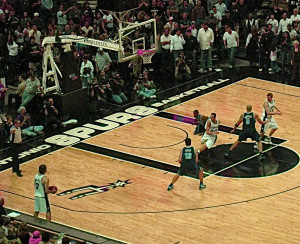Situations that demand Special Plays

Special Plays are a necessary part of basketball. A coach must use special plays to help fill in the gaps around the edges of general play. These special plays are purpose built to deal with situations that arise on a regular basis. What is hoped by introducing special plays is to create a higher chance for success by preparing for these situations specifically, and as a team.
The special situations which require a specific offensive play can be varied. There are a few situations that will be highlighted in this post to assist with a starting point when thinking about the possible plays required. What is important in having a series of special plays is not that they necessarily will result in a scoring opportunity, but rather provide a blueprint that all the team members can work towards. By having a defined game plan, possession can be more readily secured and if executed well increase the percentage of an end scoring result.
Baseline
It is inevitable that during a game the offense will receive an inbound opportunity at their offensive end of the floor. A baseline play should look to have a focus of scoring in the keyway. Because this is such a favourable position to start with the ball, a close shot around the basket should be the ultimate goal.
If a baseline play is not successful in generating a scoring opportunity, it is imperative that a team understands how to move from the baseline play into the team’s regular half-court offense.
Sideline
The sideline can happen in both the front and backcourt. Having separate special plays for each situation can provide valuable opportunities as most opposition defences will not anticipate a scoring play looking to be made from the backcourt position.
It is also valuable to note that in many sideline inbounds situations defences often extend out of their regular formation to pressure in inbound pass. This is especially rewarding for the offense if good screening actions are used to create passing opportunities heading towards the basket.
Again, because of the nature of the possession if the team does not find a suitable scoring opportunity out of the sideline play they must be able to transition into the team’s regular half-court offense plays seamlessly and without hesitation.
Jump Ball
While in most competitions a jump ball only happens once during a game, it still can be a valuable opportunity to set a tempo and mindset for a team. By scoring off the jump ball situation, a team not only takes the lead, but also provides an opportunity to defend in the full court and start to apply pressure and dictate terms to the opposition’s offense.
One Shot/Last Shot
Sometimes at the end of a quarter or game there is a situation that a team would like to only have one shot taken. This might be for example if the team has the lead and the shot clock is less than the time permitted for one possession. In this scenario rather than give the opposition and opportunity to close the gap the offensive team will try to use up the remaining time on the clock and finish with the last shot being their own.
Quick Hitter
A quick hitter is a play used for different reasons throughout a game to create a scoring opportunity. Usually a quick hitter can be performed in a very short amount of time, so it is especially useful throughout a game if the shot clock is low. Just because this play is executed in a small amount of time does not mean it has to be uncontrolled or finished with a poor shot selection situation taken.
A quick hitter play can also be used during a game to just change the tempo to see what happens or run the opposition off their feet in defence.
3-Point Play
Sometimes only a three-point shot will do and a special play is often required to get the job done. Most offenses do have three-point shooting options within them, so give some though as to if an additional special play is needed or not.
As a point of note when looking to formulate a special three-point play try to have a number of shooting options contained within the play. By doing this the play will not stall when the first scoring option is taken away.
Foul and Score
Sometimes at the end of a quarter or game, there is a need to make an offensive run to try and reclaim the lead. In these situations, a coach will need to initiate a fouling situation and then have a play ready to go for a quick scoring opportunity. Sometimes this in the half-court, and sometimes in the full court. A team will need to be drilled in fouling strategy and then being able to undertake an offensive play without the need for a time-out.
Special plays while only contributing a small amount of the overall team offense are still vital in providing confidence for the team in times of need. A good special play can help change momentum and set a different tempo. Special plays should have their place within every coach’s playbook.
Related articles







